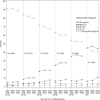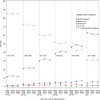Trends in breast biopsy pathology diagnoses among women undergoing mammography in the United States: a report from the Breast Cancer Surveillance Consortium
- PMID: 25603785
- PMCID: PMC4419038
- DOI: 10.1002/cncr.29199
Trends in breast biopsy pathology diagnoses among women undergoing mammography in the United States: a report from the Breast Cancer Surveillance Consortium
Abstract
Background: Current data on the pathologic diagnoses of breast biopsy after mammography can inform patients, clinicians, and researchers about important population trends.
Methods: Breast Cancer Surveillance Consortium data on 4,020,140 mammograms between 1996 and 2008 were linked to 76,567 pathology specimens. Trends in diagnoses in biopsies by time and risk factors (patient age, breast density, and family history of breast cancer) were examined for screening and diagnostic mammography (performed for a breast symptom or short-interval follow-up).
Results: Of the total mammograms, 88.5% were screening and 11.5% diagnostic; 1.2% of screening and 6.8% of diagnostic mammograms were followed by biopsies. The frequency of biopsies over time was stable after screening mammograms, but increased after diagnostic mammograms. For biopsies obtained after screening, frequencies of invasive carcinoma increased over time for women ages 40-49 and 60-69, Ductal carcinoma in situ (DCIS) increased for those ages 40-69, whereas benign diagnoses decreased for all ages. No trends in pathology diagnoses were found following diagnostic mammograms. Dense breast tissue was associated with high-risk lesions and DCIS relative to nondense breast tissue. Family history of breast cancer was associated with DCIS and invasive cancer.
Conclusions: Although the frequency of breast biopsy after screening mammography has not changed over time, the percentages of biopsies with DCIS and invasive cancer diagnoses have increased. Among biopsies following mammography, women with dense breasts or family history of breast cancer were more likely to have high-risk lesions or invasive cancer. These findings are relevant to breast cancer screening and diagnostic practices.
Keywords: atypia; breast biopsy; breast cancer diagnosis; breast pathology; ductal carcinoma in situ; false positive; mammography.
© 2015 American Cancer Society.
References
-
- Weaver DL, Rosenberg RD, Barlow WE, et al. Pathologic findings from the Breast Cancer Surveillance Consortium: population-based outcomes in women undergoing biopsy after screening mammography. Cancer. 2006 Feb 15;106(4):732–742. - PubMed
-
- Ballard-Barbash R, Taplin SH, Yankaskas BC, et al. Breast Cancer Surveillance Consortium: a national mammography screening and outcomes database. AJR Am J Roentgenol. 1997 Oct;169(4):1001–1008. - PubMed
-
- [Accessed July 24th, 2013];National Cancer Institute, Surveillance, Epidemiology and End Results (SEER) 2013 http://seer.cancer.gov.
-
- Breast imaging reporting and data system (BI-RADS) Reston, VA: Amercian College of Radiology; 2013. Radiology ACo.
-
- Carney PA, Geller BM, Moffett H, et al. Current Medico-legal and Confidentiality Issues in Large Multi-center Research Programs. American Journal of Epidemiology. 2000;152(4):371–378. - PubMed
Publication types
MeSH terms
Grants and funding
LinkOut - more resources
Full Text Sources
Other Literature Sources
Medical




